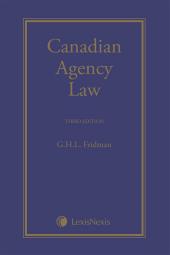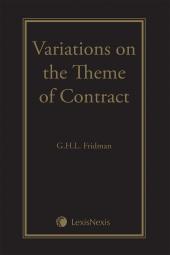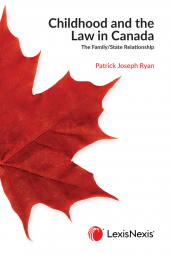Torts: A Guide for the Perplexed
In this book, Fridman presents an informative background to the law of torts so it can be better understood and appreciated by those who may find themselves somewhat confused as to its true nature and scope.
One Year Subscription Only Terms
Subscribers receive the product(s) listed on the Order Form and any Updates made available during the annual subscription period. Shipping and handling fees are not included in the annual price.
Subscribers are advised of the number of Updates that were made to the particular publication the prior year. The number of Updates may vary due to developments in the law and other publishing issues, but subscribers may use this as a rough estimate of future shipments. Subscribers may call Customer Support at 800-833-9844 for additional information.
Subscribers may cancel this subscription by: calling Customer Support at 800-833-9844; emailing customer.support@lexisnexis.com; or returning the invoice marked 'CANCEL'.
If subscribers cancel within 30 days after the product is ordered or received and return the product at their expense, then they will receive a full credit of the price for the annual subscription.
If subscribers cancel between 31 and 60 days after the invoice date and return the product at their expense, then they will receive a 5/6th credit of the price for the annual subscription. No credit will be given for cancellations more than 60 days after the invoice date. To receive any credit, subscriber must return all product(s) shipped during the year at their expense within the applicable cancellation period listed above.
Détails des produits
“I highly recommend Torts: A Guide for the Perplexed. If I were looking for a text that further discusses any of the subjects in this book … I believe Torts: A Guide for the Perplexed would be beneficial for those looking for an overview of tort law without the commitment of reading one of the lengthier, more definitive texts.”
Reviewed by Lisa Marr, Library Technician
Perley-Robertson, Hill & McDougall LLP/s.r.l
See Review in Canadian Law Library Review 43:4 (pages 23-24)
Consisting of a number of independent essays that raise and discuss ideas which permeate the modern content and function of the law of torts, this book aims to stimulate the interest of readers and to encourage them to further examine this complex topic.
A Thorough Review
Torts: A Guide for the Perplexed offers a comprehensive look at the law of torts through a number of different lenses. In particular, this volume discusses:
- Which wrongful or actionable acts fall within the scope of the law of torts by examining the nature of non-tortious wrongs (including breach of contract, breach of trust, breach of confidence, unjust enrichment, and dubious or "pseudo" torts) and how they differ from torts
- How and why tort law derives its legal authority from common law and statute
- The distinction between tort law and criminal law in relation to the "guilty mind" of the perpetrator committing the act or offence, various categories of guilt in tort law and their evolution, and the evolution of liability without guilt and the "mindless tort"
- The development of the standard of the reasonable man, the factors related to acting reasonably, why to be reasonable is necessary, when to be reasonable is necessary, where to be reasonable is necessary and how to be reasonable
- The purpose of classifying torts and the various classifications that have emerged over time, including direct and indirect, intended or unintended, public or private, by subject matter, by remedy and by significance
- The concept of justification as a means of escaping civil liability and its evolution, the distinction between justification and excuse, justification in defamation and justification in economic torts
- The historical evolution of several areas of tort liability, such as trespass, strict liability, vicarious liability, non-strict liability, intentionally tortious conduct, negligence and defamation for the purposes of exploring the development of each tort and whether it might be desirable to subject the law of torts as a whole to re-examination and rationalization
- The way common law courts have dealt with the judicial evolution of the law
- Torts and policy by expounding on the meaning of policy and the way in which and the extent to which policy has created any aspect of the law of torts
- Torts and economics, and the way economic issues can influence the exposition of torts and the provision of remedies for their commission
- The utility of torts by exploring the various purposes served by the law of torts, such as compensation, punishment, deterrence, regulation, a taxonomy of rights and equalization
- The place of torts within the structure of the law from a historical perspective
- Potential future areas of growth in the area of tort law
An Authoritative Reference Manual
Torts: A Guide for the Perplexed would be a useful resource for:
- Members of the Canadian judiciary who could refer to it when rendering decisions
- Canadian legal scholars who are carrying out research in the area of tort law
- Civil litigation lawyers who could use it to gain a better understanding of the subject matter and to help them prepare their arguments for court
- Law students who are studying tort law
- Law libraries who want to provide patrons with a comprehensive collection of materials
Table des matières
Prologue The origins and purpose of this book
Chapter 1: Notes towards the definition of tort
Chapter 2: Torts and wrongs
Chapter 3: Common law and statutory torts
Chapter 4: The mental element in torts
Chapter 5: The antithesis of tort
Chapter 6: Classifying torts
Chapter 7: Justifying torts
Chapter 8: The pathology of tort
Chapter 9: Torts and life
Chapter 10: The jurisprudence of torts
Chapter 11: Torts and policy
Chapter 12: Torts and economics
Chapter 13: The utility of torts
Chapter 14: The place of torts in the structure of the law
Chapter 15: What is to come
Epilogue: The importance of the law of torts
 Lexis Nexis
Lexis Nexis 



